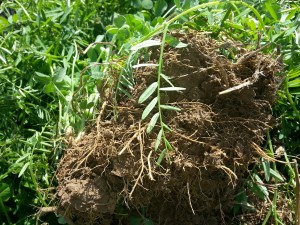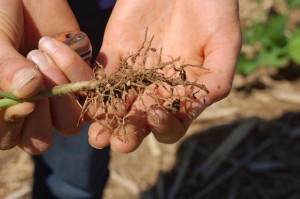Late summer is often the time to begin thinking about early spring. What will you plant and how will you get your soil in the kind of condition it

should be in for that spring planting? Many aspects of your future rotation are influenced by what you choose to plant now.
No matter what crop you plan on planting next year, it will benefit from an over-wintering crop. Many livestock producers have the misconception that if they use the crop as a forage, it won’t benefit them as a cover crop. The truly important thing, though, is to have a crop in the ground over the winter, keeping soil covered and retaining nutrients (even if those nutrients are eventually harvested for feed).
Cover crops, including those that eventually double as forage, are a cost-effective conservation practice. They contribute a variety of benefits to the field, including weed suppression, soil building, and pore formation in the soil to help alleviate compaction and increase moisture-holding capacity. A physical crop or residue barrier on the surface prevents not only erosion, but also evaporation, helping to manage and conserve soil moisture. And even when top growth is harvested, root biomass contributes to soil organic matter and helps physically break up the soil.
A winter cover crop complements nutrient management plans because it holds many manure-applied nutrients in the plant tissue, while scavenging leaching nutrients. While grasses and brassicas capture residual nitrogen from deeper soil layers, legumes fix it from the air.
Choosing crops
A mix that includes two or more species, including small grains, other grasses (usually annual ryegrass), legumes, and brassicas, is the ideal choice. As a forage crop, even a simple mix adds agronomic diversity to the ration, as well as providing a nice complement to summer annual forages.
What to plant in the fall will likely be influenced by the type of feed you need in the spring, and whether this will be for grazing, mechanical harvest, plowdown, or burndown.
It also depends on the window of time available for planting and growth in both the fall and spring. For example, maybe you have time to plant by late summer this year, but want to be able to plant the following crop next spring as soon as you can get in the field. In that case, the best thing would be a mix or straight stand that may include oats, spring barley, Daikon radish, or turnips. These crops grow rapidly in 60 days, depending largely on the tail-end of summer’s heat, but reliably don’t survive a killing frost. Instead, they leave a protective killed residue layer over winter, advantageous to no-till plant into in the spring. They also greatly improve soil tilth with their root growth; Daikon radish in particular is used to loosen soils and break up subsurface compaction.
If you’re planting a winter annual legume for the nitrogen benefit, you must leave enough time for it to grow until bloom for the most benefit. Hairy vetch often blooms in early June, while crimson clover blooms a little earlier, around mid-May.
For a mid-spring termination date, overwintering small grains work well. For strict cover crop use, they make the most nitrogen available when killed in a fully vegetative growth in the spring – before they have accumulated much carbon (lignin) to tie up nitrogen. You forego some extra carbon, but for an early spring planting, it’s better to get the nitrogen released more quickly.
We’ve found that Triticale is one of the most productive winter annual small grains (also one of the highest in digestible fiber and overall forage quality), and have built several popular mixes around it. These include:
- King’s Soil Builder Plus, a mix of triticale, hairy vetch, annual ryegrass, crimson clover, and Daikon radish. This is a high-yielding forage that is excellent for soil improvement.
- Triticale Plus, a mix of triticale and annual ryegrass. As a forage, two spring cuttings can be taken (the second will be only annual ryegrass).
- Double Play, a mix of triticale, annual ryegrass, and oats, for a fall cut and two spring cuttings. Only the triticale and annual ryegrass will be left by spring.
Rye is of course the classic fall-back cover crop option at a late planting date. It is the latest planted and earliest maturing cover crop available and produces the most for its growth period. Although it comes in behind triticale’s combination of yield and quality, it is an economical soil builder and makes a decent forage if harvested before boot stage in the spring.
The best winter mixes for building soil and making good feed are often the simplest, and can consist of a small grain and legume. The legume helps fix nitrogen and improve protein levels, but often faces competition from the small grain and will make up a small portion of the total dry matter yield.

Legume options include:
- Austrian winter peas
- Spring peas (will winter kill with hard frosts)
- Crimson clover
- Hairy vetch
- King’s 3-Way clover mix (yellow blossom sweetclover, ladino white clover, and medium red clover).
King’s additionally has a few proven fall-planted mixes, including:
- Broadcaster – For broadcasting in late summer with moisture. Great for seeding into a living corn crop and open fields in late summer. Includes MO1 and/or Marshall Annual Ryegrass, crimson clover, Common Medium Red Clover, Daikon radish, and yellow blossom sweet clover.
- CARGO – A mixture of crimson clover, annual ryegrass, and oats. It is a superb cover crop for southern Pennsylvania (south of I-78) and further south. Oats winterkill, while annual ryegrass and crimson clover over winter in warmer climates.
- Ray’s Crazy Fall Mix – This is a versatile cool season mix made up of grasses, legumes, and brassicas that can be used a short-term cover crop, a soil building transition crop to renovate depleted soils, a grazing mix, or some combination of these. It also contains several blooming species that, if left to grow and flower, will attract beneficial species.
Speak to an expert at King’s AgriSeeds now at 1-717-687-6224 or email us at [email protected].

1 Comment. Leave new
Located in Lincoln County N.C. 40 miles nw of Charlotte. We have had a severe drought in our area, no grass no hay. What could we plant for fall or winter for sheep. Allen